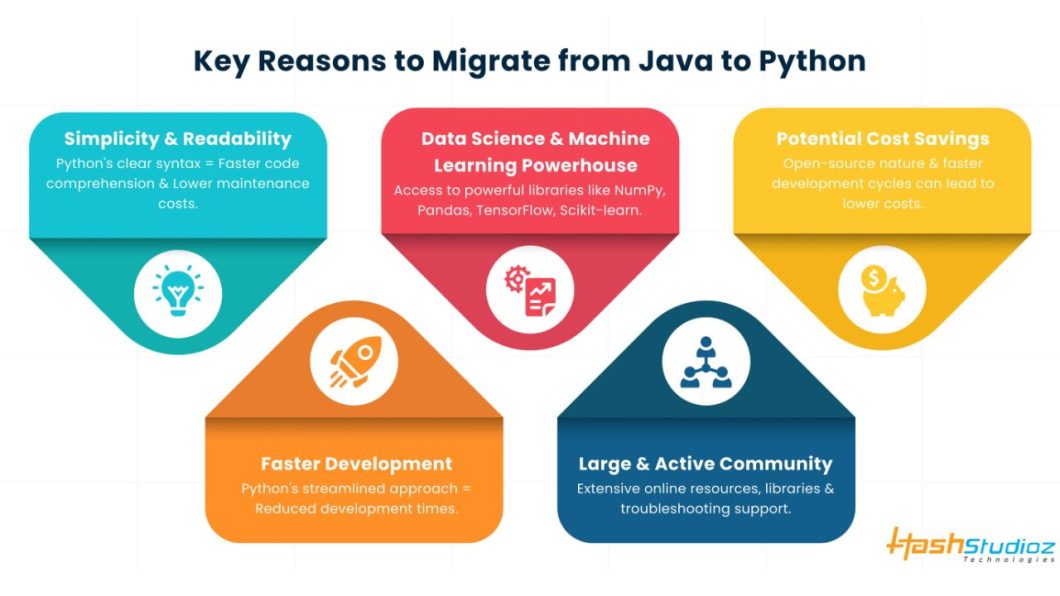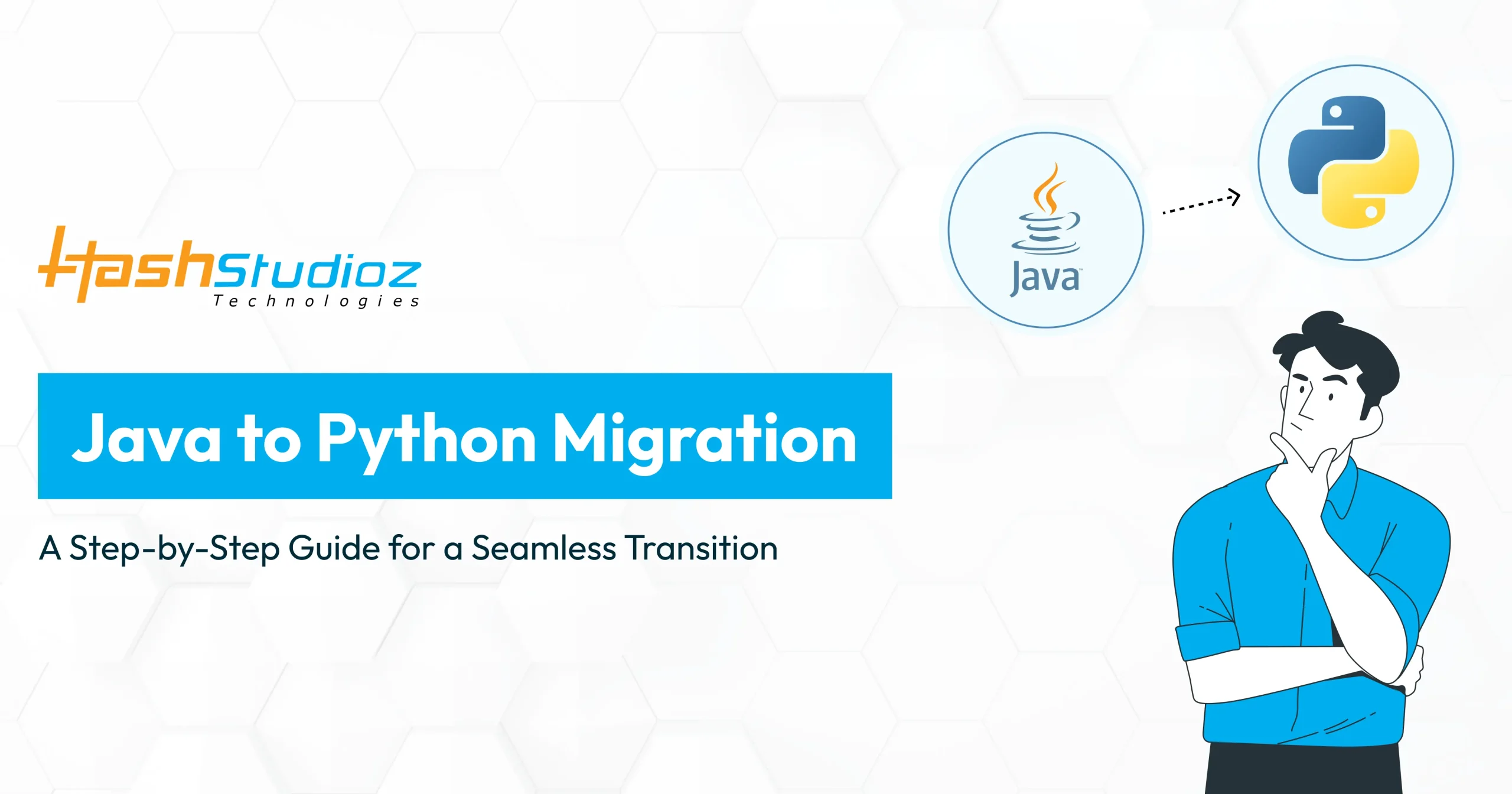Migrating from Java to Python is a strategic move gaining momentum. This shift can unlock significant advantages for businesses and developers alike. Improved development speed, access to powerful libraries for data science and machine learning, and potentially lower maintenance costs are just a few of the reasons to consider making the switch. This guide explores the key benefits of migrating, the steps involved, and best practices to ensure a smooth transition.
Table of Contents
Why Consider Migrating to Python?
Java and Python are both powerhouses in the programming world, each with its strengths. Java excels in performance and scalability, making it a favorite for large-scale enterprise applications. Python, on the other hand, shines with its simplicity, readability, and a vast array of libraries. This makes it a popular choice for developers, especially in fields like data science, machine learning, and web development.
Migrating from Java to Python: Pros and Considerations
There are several advantages to migrating your codebase to Python:
- Readability and Maintainability: Python’s syntax is generally considered simpler and more concise than Java’s. This leads to easier code comprehension and maintenance, especially for developers more familiar with Python.
- Faster Development: Python prioritizes developer productivity, often leading to faster development cycles. This is partly due to its simpler syntax and extensive libraries that handle common tasks.
- Data Science and Machine Learning Powerhouse: Python has become a dominant force in these fields. Migrating a Java project to Python grants access to powerful libraries like NumPy, Pandas, TensorFlow, and Scikit-learn.
- Large and Active Community: Python boasts a vast and active developer community. This provides access to extensive online resources, libraries, and support for troubleshooting challenges during migration.

However, migration also requires careful consideration:
- Codebase Complexity: Simpler Java code with basic functionalities is easier to migrate. Projects with intricate object-oriented structures, advanced features, or extensive third-party library dependencies might require significant refactoring or a more nuanced approach.
- Project Size: Migrating a large Java codebase can be resource-intensive and time-consuming. Carefully evaluate the potential benefits and challenges, considering long-term maintenance implications before undertaking a full migration.
- Performance: While Python excels in many areas, Java is often considered faster for computationally intensive tasks. Benchmarking and performance optimization might be necessary after migration to ensure Python meets your needs.
Preparing for a Smooth Migration
- Assess Your Current System: Before diving in, conduct a thorough assessment of your Java system. Identify critical components, dependencies, and the complexity of the codebase. This helps in planning the migration process effectively.
- Set Clear Objectives: Define your migration goals. Are you aiming to improve performance, reduce development time, or leverage Python’s libraries? Having clear objectives will guide the process and help measure its success.
- Choose the Right Tools: Tools like Jython can help integrate Java and Python, while libraries like Py4J allow Python programs to interact with JVM-based applications. Utilize these tools to facilitate the migration.
This guide outlines a step-by-step process for migrating a Java application to Python.

1. Planning and Preparation:
- Develop a Migration Plan: Create a detailed document outlining the migration process. This includes:
- Timeline: Establish a realistic timeframe with clear milestones for each stage of the migration.
- Team Management: Assign roles and responsibilities to each team member involved in the process.
- Risk Assessment: Identify potential risks associated with the migration (e.g., data loss, functionality issues) and define mitigation strategies for each risk.
- Environment Setup: Configure your Python development environment by installing the necessary tools and libraries. Ensure your environment can support both Java and Python during the transition phase. This allows for testing and gradual migration.
2. Code Translation:
- Code Conversion: Start translating the Java code to Python. This involves rewriting the codebase while considering the differences in syntax and language features between the two languages.
- Focus on Syntax: Pay close attention to the differences in syntax between Java and Python. For example, Java uses curly braces {} for code blocks, while Python uses indentation.
- Data Structure Adaptation: Identify and adapt Java data structures to their Python equivalents. For example, Java uses lists and maps, while Python uses lists and dictionaries.
- Error Handling Rewriting: Rewrite Java’s exception handling mechanisms to fit Python’s model. Python uses try and except blocks for error handling, which differs from Java’s approach.
3. Testing and Validation:
- Thorough Testing: Rigorous testing is essential throughout the migration process. Implement unit tests and integration tests to validate the functionality of the migrated code. Consider using automated testing tools to streamline the testing process and ensure comprehensive coverage.
4. Performance Optimization:
- Performance Analysis: Once the code is successfully migrated and tested, analyze its performance. Python is an interpreted language, which may lead to differences in performance compared to compiled languages like Java.
- Bottleneck Identification: Identify any bottlenecks that might be impacting performance in the migrated code.
- Code Optimization: Optimize the code to achieve the desired performance levels. This might involve techniques like using more efficient algorithms or data structures.
Post-Migration Steps
- Training and Documentation: Train your development team to ensure proficiency in Python. Update documentation to reflect the new codebase, including any changes in architecture or functionality.
- Monitoring and Maintenance: Continuously monitor the migrated system to identify and address any issues. Regular maintenance is essential for smooth operation and implementing updates or improvements.
Conclusion
Migrating from Java to Python can offer numerous benefits, from faster development cycles to leveraging powerful data science and machine learning libraries. By following a structured migration process and addressing key considerations, organizations can achieve a seamless transition and potentially unlock cost savings. Python’s focus on developer productivity can lead to faster development times, reducing overall project costs. Additionally, Python’s open-source nature eliminates licensing fees associated with some proprietary Java libraries. Evaluating the potential cost savings alongside the other benefits can strengthen your case for migrating to Python.

FAQs: Migrating from Java to Python
1. Is migrating from Java to Python always the right decision?
Not necessarily. While Python offers many advantages, Java remains a powerful language for large-scale enterprise applications and computationally intensive tasks. Consider the complexity of your project, your performance requirements, and the long-term maintenance implications before deciding to migrate.
2. What are the biggest challenges associated with migrating from Java to Python?
The complexity of your codebase is a major factor. Migrating large or intricate projects with object-oriented structures or extensive third-party dependencies can be time-consuming and require significant refactoring. Additionally, ensuring performance meets your needs after migration might involve optimization if Python’s execution speed falls short for specific tasks compared to Java.
3. How long does it take to migrate a Java project to Python?
The timeframe depends on the project’s size and complexity. Simple projects might take weeks, while large-scale enterprise applications could require months or even a year. Careful planning, resource allocation, and a well-defined migration strategy are crucial for efficient processes.
4. What are some tools that can help with the migration process?
Several tools can ease the transition. Jython allows for integration between Java and Python, while libraries like Py4J enable Python programs to interact with Java Virtual Machine (JVM)–based applications. Additionally, automated testing tools can streamline the testing process and ensure comprehensive coverage of the migrated code.
5. Should I hire a development team or a Java development company to assist with the migration?
While this guide provides a roadmap, seeking professional help can be beneficial. Partnering with a skilled development team or a Java development company with experience in migration projects can provide valuable expertise, ensure a smoother transition, and mitigate potential risks. Their knowledge can save you time and resources and ensure your migration’s success.

